How to Build a Multi-Review Platform Strategy Playbook
Post-pandemic, the world is opening back up, mask mandates are lifting, travel is at an all-time high, and in-person events are becoming highly sought after. Yet in the B2B world, buyers have normalized to the digitization and having product information readily available without sales pitches, demos, meetings, form fills, or on-camera calls. As many of us continue to work remotely, we understand the fatigue that comes from receiving a bombardment of emails, social media ads, and LinkedIn messages. And when it comes to purchasing software, B2B tech buyers are also leaning toward different methods of discovering new products. The biggest shift—today’s buyer prefers to self-serve part or all of their buying journey. Plus, 57% of buyers make purchase decisions without ever talking with a vendor representative. But the question remains, “how?”
While the pandemic shaped buyer behavior toward self-service models, there’s one group of people who were already headed that way before the pandemic happened: millennial buyers.
Our recent B2B Buying Disconnect report revealed that millennials (age 25-39) make up 60% of all B2B tech buyers. They tend toward self-service even more than other audience segments, with 87% of them reporting that they want to self-serve part or all of their buying journey.
With all this evidence of a growing interest in self-service models, software review sites actually scored as one of the top choices when it comes to researching products. Customer reviews play double-duty, as they serve as both trusted third-party validation and self-service resources for customers to consult. In fact, our research shows reviews are more trusted than a vendor’s website or marketing materials. After all, when it comes to trustworthiness and influence, not all information sources or engagement tactics are created equal. We also found that buyers view free trial/accounts, product demos, and user reviews as the most trustworthy methods for evaluating software. Vendor marketing materials didn’t make the list.
However, it’s not enough to just get onto a single review site, claim your profile, and call it a day. It’s important to position your brand where your audience is engaging. And in today’s digital era of content at your fingertips, you need to think of review sites as your best-performing marketing channels.
In this playbook, we’ll be covering why it’s important for B2B marketers and sellers to have an established presence on multiple review sites, what that looks like in practice, and how building a multi-review platform strategy can enhance your ability to generate pipeline, increase win rates, and retain and upsell existing customers.
“See in the dark” with multiple review platforms
Having a multi-review platform strategy is the best way to “see in the dark.” You’ve heard of “dark social” or the “dark funnel,” but have you figured out how to navigate it yet? These phrases are indicative of elusive customers who are becoming increasingly hard to reach, engage, and convert. Winning B2B companies are mining different types of intent data and integrating it into their tech stack, offering personalized messages to hopefully find and win in-market buyers. Since buyers are actively researching your product or your competitors’ on review sites like TrustRadius, they can be a great source for intent data. Marketers using downstream intent data see an increase in return on advertising spend (ROAS) while also not exhausting their sales teams.
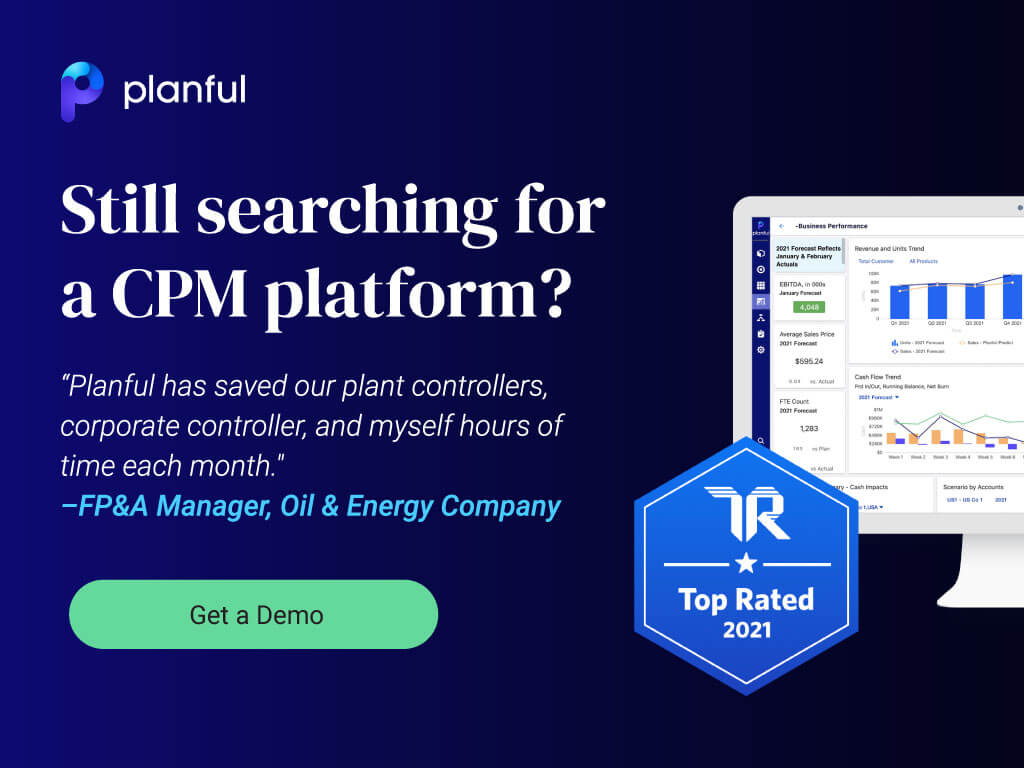
Having a multi-review site strategy is the best way to:
- Reduce CPA on paid advertisements
- Prospect downstream, in-market buyers
- Scale your content using the voice of the customer
- Identify use cases, business challenges, or case studies
- Deliver qualified leads to your sales team
So why aren’t more companies turning review sites into one of their best-performing marketing channels?
Myth #1: One review site is enough.
Most think having an establishing presence on one review site is enough. Well, take TrustRadius’s review site stats as an example. According to data from SEMRush, only 20% of TrustRadius’ traffic overlaps with G2, and just 10% overlaps with Gartner Peer Insights. Because of this lack of overlap, only concentrating on one of these places means that a large sector of your potential audience will miss seeing your products. In essence, by only leveraging one review site, you’re failing to influence your audience who are researching elsewhere.
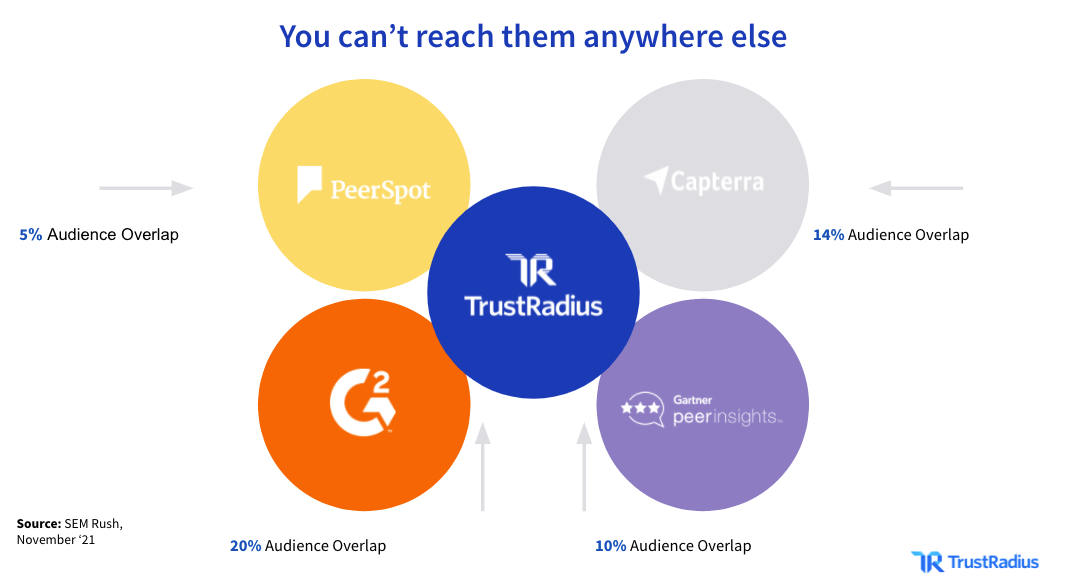
Myth #2: Negative reviews are terrifying!
One of the biggest fears of setting up profiles on multiple review sites: “the more sites we’re on, the more likely we’ll collect negative reviews because of a broader audience.”
Well, it turns out that negative reviews aren’t as detrimental as we may think. In fact, a lot of common household names such as Zoom have 1-star ratings on most review sites. By addressing negative reviews with empathetic and detailed comments, low ratings become golden opportunities to prove that you’re willing to engage with all customers—not just the positive ones that love your product.
In addition, when we surveyed buyers, we found that…
- Too many positive reviews looks suspicious (they may even think back to review site scams that they’ve heard about over the past few years)
- Negative reviews often push them to do more research rather than give up on the product altogether
- They will sometimes not even consider a product without negative reviews because it could indicate a lack of widespread adoption across the industry
Multi-review platform strategy benefits
While it’s clear that using multiple review sites makes sense with the preferences of today’s audiences, it might be difficult to convince stakeholders that it’s a worthwhile use of resources. Let’s face it, being on more than one site can get time-consuming. It may seem like getting a presence on one or two “high-profile review sites” might be good enough. However, in addition to that lack of overlap we mentioned, there are a few other big reasons to add multiple review sites to your business strategy:
- You’ll have a presence wherever your buyers might go
If a potential buyer happens to check out a site that you aren’t on yet, they’re more likely to choose a competitor who is on it, simply because they’re not remembering that you exist and can also solve their pain points.
- Better SEO
A key SEO best practice: putting your keywords out on the web as frequently as possible. The more content that references your brand and keywords, the better your SEO will become. Review sites count as this type of content, especially when you fill in your vendor profiles with keyword-smart descriptions.
- Better traffic to your site
Putting your brand in front of more viewers will lead to more clicks and visits to your site.
- More reviews = more customer voice to use in your own channels
Each review platform collects customer reviews differently. For example on TrustRadius, you can create a custom questionnaire to collect reviews that highlights the use cases and features you want to be known for. Also, the reviews are on average 400+ words, while the word count is 50 or less on most other sites. Reviews on TrustRadius give you a ton of content to harvest customer quotes and stories to use across your marketing and sales efforts.
Review sites to consider
So, where’s the best place for vendors to start when looking at review sites? Every review site has different characteristics that will open up your brand to a distinct audience. Here are a few unique aspects to consider:
TrustRadius
TrustRadius focuses on providing decision-makers across industries with verified, peer-based guidance, research, and high-value intent data. Vendors targeting enterprise and/or mid-market sectors can engage and convert their target audience by telling a unique story on TrustRadius through detailed, thoughtful user reviews.
G2
G2 is large-scale and recognizable by name, with five million monthly buyers. They reach out to a notable audience of mostly SMB buyers. But also, because this site is so large-scale, not all G2 reviews are useful, as the reviews are often short, unvetted, and written by unverified users (none of the site users are required to identify their names or company information).
Gartner Peer Insights
Gartner Peer Insights is also a large-scale and recognizable review site. It’s especially significant for many because it’s supported by Gartner, known for its research, Magic Quadrants, and conferences. Gartner does face the same review pitfalls as G2 because of its size, and the Magic Quadrants have limits because they only consider score and not sentiment.
Capterra
While not as large-scale as G2 or Gartner, Capterra is still fairly well-known. It works best for larger enterprises, as its pay-to-play structure mainly caters to vendors that can pay a significant amount for lead optimization.
PeerSpot
PeerSpot, formally IT Central Station, specializes in IT-specific technologies like cybersecurity, DevOps, and IT. The reviews on PeerSpot are generated mostly via phone conversations. Most vendors use PeerSpot as a boutique review platform for a more technical audience.
SoftwareAdvice.com
SoftwareAdvice.com’s main differentiator is their 1-to-1 advisory feature, which provides a software advisor to customers, exposing your product to an audience that seeks this type of service.
Why TrustRadius should be at the top of your list
As a research and review platform, TrustRadius can play a significant role in your multi-review site strategy. Here are a few of our differentiators:
Every review is vetted by a real person for authenticity
We surveyed our audience and found that authenticity is the top value for review sites. With the review fraud uncovered on B2C review sites such as Amazon and Yelp, many buyers can be wary of trusting review sites unless the site can prove that the feedback is authentic. No other review sites vet their reviews to the extent that TrustRadius does.
On average, TrustRadius reviews have 400+ words
According to one of our customers who was trying to find useful information on another review site: “I expect[ed] the reviews I read to give me an honest view of how it performed, and how it did not perform. Instead I did see a lot of ‘I liked it’ ‘I did not like it’ statements, with very little background as to specifics.”
This isn’t an issue on TrustRadius, as most of our reviewers leave detailed, thoughtful reviews that benefit both vendors and potential buyers.
On average, users spend ~11 minutes comparing products
Because they aren’t just clicking away from the reviews within seconds or minutes, we can see that our audience is serious about researching and considering a purchase.
TrustRadius provides actionable downstream intent data
On TrustRadius, we show exactly what your in-market audience is doing on our site and collect your entire category’s intent signals. We collect intent data directly from our reviews (known as product intent data) and from engagement as buyers research your solution’s entire category (known as category intent data). In comparison, G2’s signals are diluted, as they include extraneous metrics on blog traffic mixed with review data.
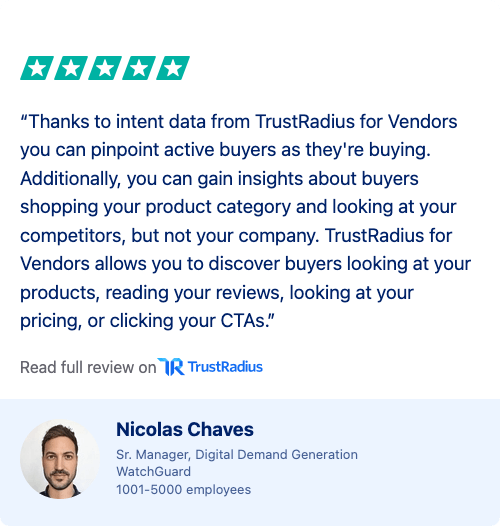
TrustRadius’s category intent data provides a competitive edge by allowing you to see your entire category’s intent signals, collected as your audience browses and engages with various solutions within your set category. With this data, you can do a true competitive takeout campaign with all the data necessary. G2, on the other hand, displays comparisons, but not category data if your competitors are paying them too.
Downstream intent data allows the collection of quality leads. These are actual, in-market buyers who are either researching your product directly or engaging with similar products and competitors on TrustRadius. It also provides marketing and sales teams with the insights they need to bring up relevant messaging during outreach.
According to Erin Christopher, Director of Demand Generation at Totango, a customer success platform, “I think it’s about learning and being nontraditional and willing to look at where people are getting their information and then getting creative.”
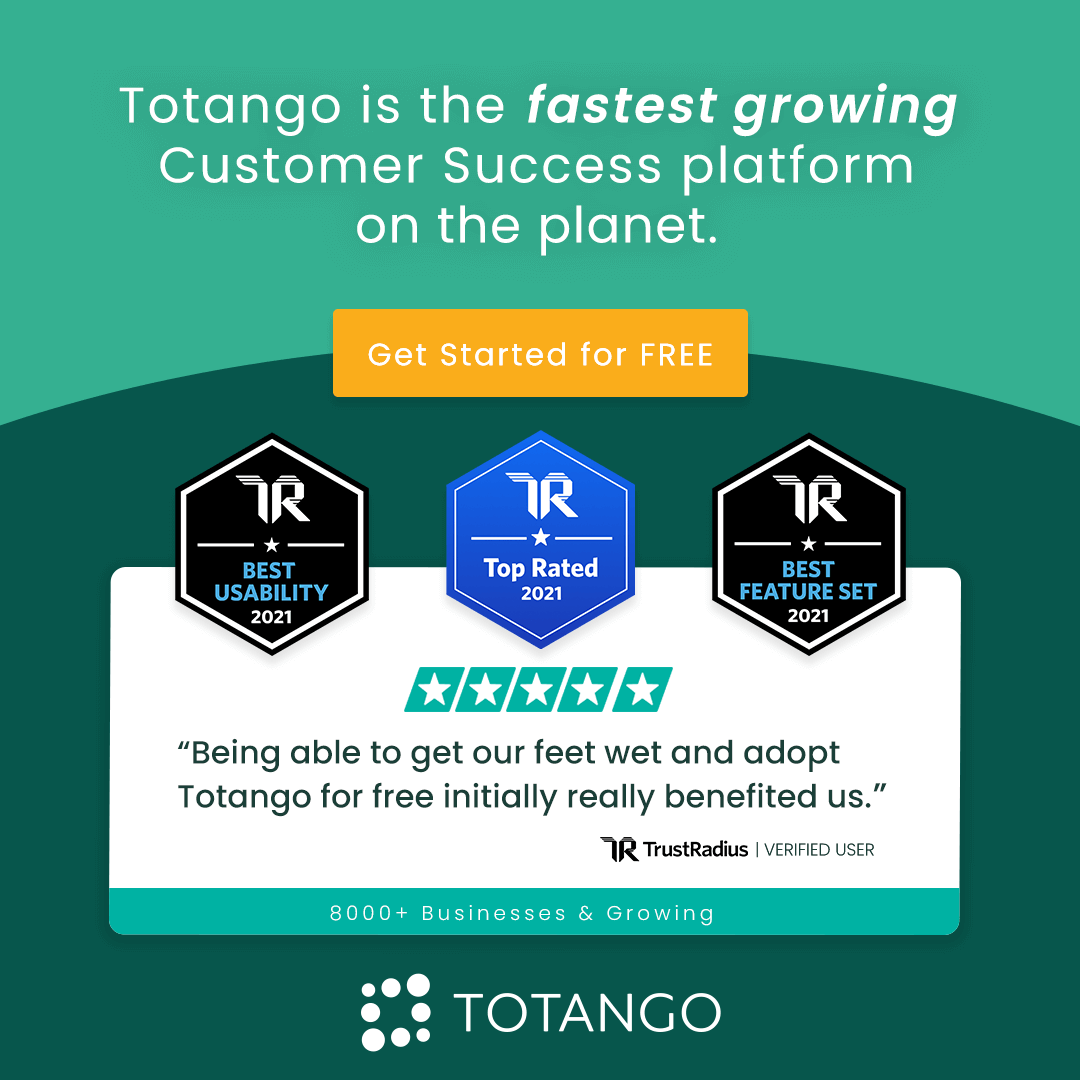
TrustRadius integrates with other pieces of our clients’ tech stacks
To make the lives of marketers easier, we’ve built data integrations with LinkedIn and Salesforce, and ABM platforms like Demandbase. A few of the integrations include:
- Salesforce, for including reliable intent data with your prospecting, existing pipeline, and helping you reduce churn
- 6sense, for engaging accounts with knowledge from valuable second-party downstream intent signals to complement third-party and topical intent
- LinkedIn, for integrating downstream intent data into your ad campaigns to target and convert in-market buyers
- Demandbase, for using comprehensive intent data and deal intelligence from TrustRadius to boost ABM performance and accelerate deal cycles
Tips for building a multi-review site strategy
So, maybe you’re ready to start investing in a multi-review site strategy and start seeing more reach to in-market buyers, better engagement, and SEO growth. But, where’s the best place to start? We’ve got a few recommendations:
Claim your company and product profile(s)
First, you need to claim your profile on several review sites. As we mentioned earlier, review sites become an opportunity for SEO, so it’s important to optimize every fillable space on your profile for SEO and user intent.
Solicit/incentivize customer feedback
Next, plan a strategy for inviting customers to leave reviews. There are a few different ways to do this. For instance, you might initially think that direct invites to leave reviews would be pushy. However, three out of four buyers say they’re willing to advocate for the product they bought.
Create custom questions
To solicit customer feedback, it’s a good idea to prompt your customers with custom questions. This allows you to guide your customers to include details about your product that they otherwise wouldn’t have thought to include.To help you collect valuable reviews from your customers, we’ve got a feature to invite your customers to a unique TrustRadius landing page with custom questions and a message from your company.
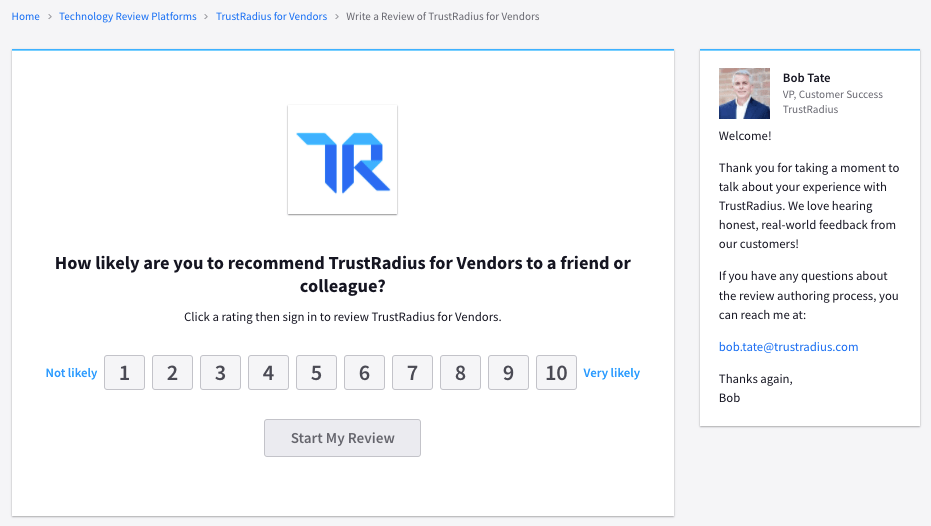
Get started today
We hope you’re feeling empowered and ready to get started on your multi-review strategy. Adding your products to several review sites not only increases your SEO and site traffic, it exposes your brand to an entirely new audience who’s ready to learn more and make a purchase.
To get started on your review journey with TrustRadius, request a demo.
Additional Resources:















